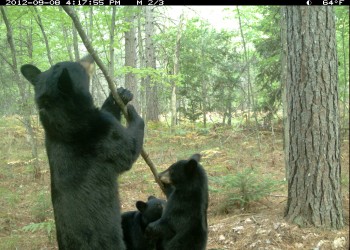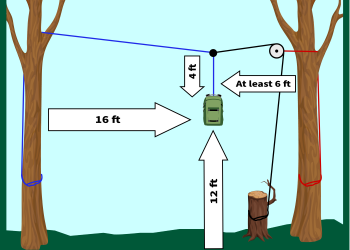Boundary Waters Canoe Area Wilderness Rules and Regulations
Read on to find commonly asked questions and answers regarding your trip to the Boundary Waters Canoe Area Wilderness. To preserve the values you are travelling to experience, some regulations have been established.
U.S. Department of Agriculture, Forest Service regulations are enforceable with a maximum penalty of $5,000 and/or 6 months in jail.
Please remember to check out the BWCAW Trip Planning Guide for everything you need to know when planning your visit.
Watercraft
Motor-powered watercraft are permitted only on the following designated lakes with horsepower restrictions. All other lakes or portions of lakes within the Boundary Waters Canoe Area Wilderness are paddle-only.
Motors may not be used or be in possession on any paddle- only lake. No other motorized or mechanized equipment (including pontoon boats, paddle boats, sailboats and sailboards) is allowed.
Portage Wheels
Mechanical assistance is only permitted over the
- Four-Mile Portage, Fall-Newton-Pipestone and Back Bay Portages into Basswood Lake, Prairie Portage and Vermilion-Trout Lake Portage
Lakes with 10 Horsepower (HP) Limit
On these lakes, the possession of one additional motor no greater than 6 HP is permitted, as long as motors in use do not exceed 10 HP
- Clearwater,
- North Fowl,
- South Fowl,
- Seagull (no motors west of Three Mile Island),
- sections of Island River within the Boundary Waters Canoe Area Wilderness.
Lakes with 25 HP Limit
On these lakes or portions of these lakes, the possession of one additional motor no greater than 10 HP is permitted, as long as motors in use do not exceed 25 HP
- Basswood (except that portion north of Jackfish Bay and Washington Island),
- Saganaga (except that portion west of American Point),
- Fall,
- Newton,
- Moose,
- Newfound,
- Sucker,
- Snowbank,
- East Bearskin,
- South Farm,
- Trout
Lakes with no HP Limits
- Little Vermilion,
- Loon,
- Lac La Croix (not beyond the south end of Snow Bay in the USA),
- Loon River
- Only watercraft and equipment used in connection with your current visit may be stored and left unattended.
- All equipment and personal property must be carried out with you at the end of each trip.
Campsites and Campfires
- All members of a permit group must camp together. Only one campsite per group.
- During ice free season, camp only at Forest Service designated campsites that have steel fire grates and wilderness latrines.
- When in a busy area, travel further in and away from the periphery if capable.
- It is illegal to cut, hack or deface live vegetation for any reason.
- You may camp up to fourteen (14) consecutive days on a specific site.
- Place your tent in areas with no vegetation—keep campsites small.
- Due to potential fire danger, fire restrictions may be put into effect. Check on current conditions just prior to your trip. You may be required to use a camp stove if there is a campfire restriction.
- Bringing a small camp stove is a good idea because it heats food more quickly, has less impact than a fire, and comes in handy during rainy weather.
- Fires are allowed only within the USFS steel fire grates at designated campsites or as specifically approved on your visitor’s permit.
- If you build a fire, burn small diameter dead wood found lying on the ground.
- Do not burn trash. Burning plastic pollutes air and water.
- Collect firewood well away from campsites by paddling down the shore and walking into the woods where it is more abundant.
- Dead and downed wood easily broken by hand or cut with a small folding saw eliminates the need for an axe. Never cut a live tree!
- Transporting wood from out of state is prohibited due to the spread of tree diseases and pests.
- Drown your fire with water any time you are going to be away from your camp or at bedtime. Stir the ashes until they are cold to the touch. Never leave a campfire unattended, 9 out of 10 wildfires are caused by humans.
When You Bring
- Possessing any cans or glass bottles is illegal, except containers of fuel, insect repellent, or medicines.
- Carry food and drinks only in containers designed and intended for repeat use to prevent more trash.
- Drone operation is prohibited in the Boundary Waters Canoe Area Wilderness.
- Violations punishable under federal law Executive Order 10092 and 36 CFR 261.18(a).
- Discharging a firearm is prohibited within 150-yards of a campsite or occupied area, or in any manner or location that places people or property at risk of injury.
- Firearm and game laws apply in the Boundary Waters Canoe Area Wilderness.
- Fireworks of any kind are illegal.
- Dogs endanger wildlife and barking intrudes on the experience of others.
- Dogs must be under human control at all times on a 6-foot or shorter leash.
- Dispose of dog waste 200 feet* from water sources, campsites and portages, or deposit it in a latrine.
*200 feet is approximately 70 big steps for adults and 120 for kids!
Leave No Trace
- Leave archaeological, historical and rock painting sites undisturbed.
- The use of metal detectors is prohibited.
- When preparing for your trip, reduce litter at the source by minimizing packaging.
- Plan your meals so you don’t have leftovers. If you do, pack them out.
- Dump bait bucket water before every portage and refill on the other side. Dispose of fish remains at least 200 feet* from shorelines, campsites, trails, and portages. MN state law prohibits dumping unused bait into water, pack it out.
- Dumping bait on the ground is considered littering. Therefore, unwanted live bait should be packed out with you and placed in the trash, disposal bins or compost bins.
- Never leave food unattended on portage trails or in camp, or other scented items in your tent at any time. Doing so attracts bears and encourages unnatural populations of some species. Use a bear-resistant container or ropes to hang food packs.
- Latrines are not garbage cans! Trash in the latrine harms wildlife. Burning trash is illegal and it pollutes the air and soil. Pack it in, pack it out! When breaking camp, make sure your campsite and fire grate are free of trash.
*200 feet is approximately 70 big steps for adults and 120 for kids!
- Nine (9) people and four (4) watercraft are the maximum allowed together in the wilderness.
- You may not exceed the limit as a group at any time or anywhere (on water, portages, campsites) in the Boundary Waters Canoe Area Wilderness.
- Smaller groups enhance your wilderness experience and chanc s of seeing wildlife, and decrease resource impacts.
Wilderness permits are required year round for hiking in the Boundary Waters Canoe Area Wilderness.
- Trail users are encouraged to minimize impact by limiting use to one night on non-developed sites.
- You must camp more than 200 feet from a developed site or another group.
- You must camp at least 200 feet from any trail, portage, lake or other water source.
- Most importantly, be sure to use common sense.
*200 feet is approximately 70 big steps for adults and 120 for kids!
- After you break camp and load your watercraft, do a final inspection of your camp. Pick up any remaining litter.
- Your fire must be cold to the touch.
- Please treat the Boundary Waters Canoe Area Wilderness with care. Leave no trace of your visit to protect this special place for future generations.
- Use wilderness latrines at designated campsites.
- Wilderness latrines are not garbage cans and should be used for the intended purpose only. Personal waste items such as cigarettes, cotton swabs, grease, wipes, paper towels, bandages, diapers, condoms, plastic baggies and female products (tampons, pads and applicators), should always be packed out and never go into the latrines.
- Personal waste in latrines prevents decomposition of bodily waste making latrines ineffective and can contaminate surrounding water. Remember all trash must be packed out.
- If you’re not near a latrine, dig a small hole 6–8 inches deep at least 200 feet* or more back from the water’s edge. When finished, fill hole and cover with needles and leaves.
- Bathe and wash dishes at least 200 feet from lakes and streams.
- All soaps pollute water including soaps labeled “biodegradable.” Always remember the visitors that come after you and the water they will drink.
*200 feet is approximately 70 big steps for adults and 120 for kids!
Permits
Permits are required year-round for all day and overnight visits to the Boundary Waters Canoe Area Wilderness because entry points and dates regulate visitor distribution and support solitude.
- You must enter the Boundary Waters Canoe Area Wilderness at the entry point and on the entry date shown on your permit.
- You may not re-enter on a different date using the same permit.
- Permit stubs become invalid when the group leader exits the wilderness.
- The person signing for and picking up the permit can only be responsible for one group during the specified time on the permit.
- Carry your permit with you at all times.
Bear Safety

Boundary Waters Canoe Area Wilderness is bear country. Make sure to take steps to keep yourself and your family/friends/pets safe while visiting.
- Never approach a bear or other wild animal;
- Keep dogs and other pets under control, or leave them at home;
- Do not hike in the dark;
- If a bear approaches you, back away slowly; do not run;
- Carry EPA registered bear pepper spray;
BWCAW Food Storage Order

Prohibitions related to food, food containers, etc. in the Boundary Waters Canoe Wilderness Area from March 1 - November 30 of each year.
All
- food,
- food containers,
- scented items (such as soap, lip balm, toothpaste) and
- refuse
shall be suspended at least 12 feet above the surface of the ground and not less than 6 feet horizontally from the trunk of a tree, or stored in an Interagency Grizzly Bear Committee certified bear resistant container.



